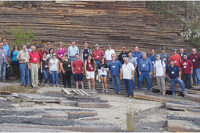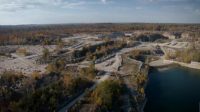The origin of this tour took root in June 2013, when the MIA met with the Elberton Granite Association (EGA) board of directors to discuss two important industry initiatives. At that time, the MIA was deeply involved with establishing a national advertising campaign (commonly referred to as a “check-off” program), as well as working with the U.S. Environmental Protection Agency to produce two new scientific studies looking into the safety of granite quarry and fabrication workers with respect to radon and radiation exposure. The EGA made a financial pledge to assist with both studies (which have since been completed) and also extended an invitation to visit again.
That invitation evolved into a full-fledged quarry tour with Elberton as the backdrop for the first of a two-day event. The EGA, with leadership from Matthew Pruitt, arranged for tours of two quarries, two production facilities, a visit to a tooling supplier, a granite museum and much more.
The attendees, which included stone professionals from 15 states, also represented a wide cross section of the industry. From quarrier to restoration professional, this event was truly a stone classroom in which everyone could gain in stone knowledge and make new business connections.
Day one
The first stop on the Elberton tour was the Keystone Quarry. The primary use of the stone extracted at Keystone is for the monument industry. The broader Elberton granite industry represents one-third of all U.S. monument production. The attendees witnessed a deep pit quarry, and for many on the tour, this was their first quarry experience so their eyes were wide open and many pictures were taken. Pruitt explained that the use of derricks had been eliminated in this quarry and replaced with mobile cranes, which provided easier access, as the stone extraction moved within the quarry to bring granite blocks to the surface.
A priority of the tour schedule was to highlight as many different approaches to quarrying and stonework as possible. The next stop, at the Blue Sky quarry, provided a look at a drive-in granite quarry using wire saw technology. Approximately 120 blocks of stone are quarried weekly and shipped to Massachusetts by rail for curbing. In terms of cubic feet of production, this represents between 60 to 85K linear feet monthly.
With several attendees from the quarrying sector, the discussion about efficiencies of wire versus saw techniques evolved into a compare and contrast of water and power consumption expenses. The conversation quickly shifted to the differences that limestone and marble producers experience (as opposed to granite producers) when using the same technologies. It was a great classroom setting in the field.
The next stops were the Georgia Guidestones monument followed by a tour of Miles Supply. The monument is 19 feet, 3 inches tall, made from six granite slabs weighing 120 tons. One slab stands in the center, with four arranged around it. A capstone lies on top of the five slabs, which are astronomically aligned. An additional stone tablet, which is set in the ground a short distance to the west of the structure, provides some notes on the history and purpose of the Guidestones.
Miles Supply hosted lunch and showcased several new products at their Elberton showroom. In addition, they provided helmets and safety glasses for the two-day event, as they have done on many previous tours. The afternoon tour shifted to stone production. Keystone Memorial’s George and Tom Olgesby, both past EGA presidents, led the tour. They provided attendees with a look at a wide range of equipment used in memorial production. While some of the equipment has been in use for decades, new technology is emerging on the scene. Attendees saw a Breton Shape Mill in use. It was quite remarkable to visit with one of the Keystone stone carvers and listen to how new technology, coupled with time-tested stone carving, is coming together. He talked at length about efforts to take both to a local trade school in order to perk the interest of young people. Recruiting new talent to the stone industry is an important initiative for this community of approximately 5,000 people.
The next stop was at Star Granite & Bronze to see its bronze foundry. For many, this was a first glimpse into that segment of the industry. Established in 1951, they operate a wholesale quarry and foundry, and manufacture a wide range of architectural plaques and signs. This stop also highlighted how type-setting for the bronze memorials is a combination of both human and computer-generated technology.
The first day was capped off with a tour of the Elberton Granite Museum and dinner hosted by Parfleet Equipment. The museum tour provided a nice historical perspective of the evolution of the Elberton granite industry since its birth in 1889. For those who have attended the MIA tour in Barre, VT, it would be unfair to compare and contrast. Both are great tours. Yet, with over 40 quarries and over 200 stone companies in the region, it is surprising that MIA didn’t host a tour in Elberton until 2014.
Day two
The second day of the tour returned the MIA to its roots — Tate, GA, and the Georgia Marble Quarry that has hosted several MIA tours over the years. The quarry, now owned by Polycor, provided the attendees with an up-close look at marble extraction. Attendees saw first-hand how Polycor utilizes a strategy of 100% stone usage. They explained that all stone not used in block or slab form is ground into marble dust or aggregate to support other industries. During the production facility tour, Polycor showcased both wire and gangsaw production of marble slabs as well as production of its Vertrazzo product line.
The afternoon consisted of tours at two MIA Accredited companies of uniquely different proportions. The Crystal Marble Co. of Cummings GA, a commercial contractor, provided an overview of drafting and shop drawing procedures they follow to aide installation oversight with general contractors on the jobsite. Clifford Brannon showcased some of the company’s recent work at Emory University, which further highlighted the importance of its drafting department and relationships with its fabricators. For some from the countertop sector, the overview was an eye opener into the complexities and differences between the commercial and residential segments of the industry.
The final stop on the tour was to Premier Surfaces in Alpharetta, GA, an MIA Accredited fabricator. This stop highlighted the operational efficiencies that those in the fabrication sector are gaining by being fully integrated. Kris Kelough conveyed how important the use of technology, along with topnotch people, is to their firm. He pointed out several aspects of how they use equipment from Slabsmith, Laser Products and Prodim to interface with the company’s Park Industries and Northwood equipment. Premier’s commitment to customer service was also evident by a wall in its showroom filled with testimonials from happy customers.
The two-day event was labeled a “quarry” tour, but it was much more than that. It was two days of intense networking. For those that are interested in future events, the Building Stone Institute (BSI) will hold a study tour in Banff, Alberta Calgary, Canada, from September 21 to 24, 2014. Next year, the MIA will return to Vermont from October 21 to 22, 2015.






